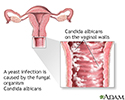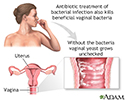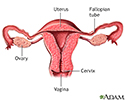Vaginal yeast infection
Yeast infection - vagina; Vaginal candidiasis; Monilial vaginitisVaginal yeast infection is an infection of the vagina. It is most often due to the fungus Candida albicans.
Causes
Most women have a vaginal yeast infection at some time. Candida albicans is a common type of fungus. It is often found in small amounts in the vagina, mouth, digestive tract, and on the skin. Most of the time, it does not cause infection or symptoms.
Vagina
The vagina is the female body part that connects the womb (uterus) and cervix to the outside of the body.

Candida and the many other germs that normally live in the vagina keep each other in balance. Sometimes the number of candida increases. This leads to a yeast infection.
This can happen if:
- You are taking antibiotics used to treat another infection. Antibiotics change the normal balance between germs in the vagina.
- You are pregnant
- You are obese
- You have diabetes
Diabetes
Diabetes is a long-term (chronic) disease in which the body cannot regulate the amount of sugar in the blood.
 ImageRead Article Now Book Mark Article
ImageRead Article Now Book Mark Article - You are taking medicines or have an illness that suppresses your immune system.
A yeast infection is not spread through sexual contact. However, some men may develop symptoms after having sexual contact with an infected partner. These symptoms may include itching, rash or irritation of the penis.
Itching
Itching is a tingling or irritation of the skin that makes you want to scratch the area. Itching may occur all over the body or only in one location...

Rash
Rashes involve changes in the color, feeling or texture of your skin.

Having many vaginal yeast infections may be a sign of other health problems. Other vaginal infections and discharges can be mistaken for a vaginal yeast infection.
Symptoms
Symptoms include:
- Abnormal vaginal discharge. Discharge can range from slightly watery, white discharge to thick, white, and chunky (like cottage cheese).
Abnormal vaginal discharge
Vaginal discharge refers to secretions from the vagina. The discharge may be:Thick, pasty, or thinClear, cloudy, bloody, white, yellow, or greenOdor...
 ImageRead Article Now Book Mark Article
ImageRead Article Now Book Mark Article - Itching and burning of the vagina and labia
- Pain with intercourse
- Painful urination
Painful urination
Painful urination is any pain, discomfort, or burning sensation when passing urine.
 ImageRead Article Now Book Mark Article
ImageRead Article Now Book Mark Article - Redness and swelling of the skin just outside of the vagina (vulva)
Exams and Tests
Your health care provider will do a pelvic exam. It may show:
- Swelling and redness of the skin of the vulva, in the vagina, and on the cervix
Vulva
The vulva is made up of the female genital parts that are outside the body. It includes the "lips" or folds of skin (labia), clitoris, and the openi...
 ImageRead Article Now Book Mark Article
ImageRead Article Now Book Mark ArticleVagina
The vagina is the female body part that connects the womb (uterus) and cervix to the outside of the body.
 ImageRead Article Now Book Mark Article
ImageRead Article Now Book Mark Article - Dry, white spots on the vaginal wall
- Cracks in the skin of the vulva
A small amount of the vaginal discharge may be examined using a microscope. This is called a wet mount and KOH test.
Vaginal discharge
Vaginal discharge refers to secretions from the vagina. The discharge may be:Thick, pasty, or thinClear, cloudy, bloody, white, yellow, or greenOdor...

Wet mount
The vaginitis wet mount test is a test to detect an infection of the vagina.

Sometimes, a culture is taken if:
- The infection does not get better with treatment
- The infection recurs
Your provider may order other tests to check for other causes of your symptoms.
Treatment
Medicines to treat vaginal yeast infections are available as creams, ointments, vaginal tablets or suppositories and oral tablets. Most can be bought without needing to see your provider. If you do need to see your provider, you may wish to ask them about the use of boric acid for yeast infections.
Treating yourself at home is probably OK if:
- Your symptoms are mild and you do not have pelvic pain or a fever
- This is not your first yeast infection and you have not had many yeast infections in the past
- You are not pregnant
- You are not worried about other sexually transmitted infections (STI) from recent sexual contact
Medicines you can buy yourself to treat a vaginal yeast infection are:
- Miconazole
- Clotrimazole
- Tioconazole
- Butoconazole
When using these medicines:
- Read the package inserts carefully and use them as directed.
- You will need to take the medicine for 1 to 7 days, depending on which medicine you buy. (If you do not get repeated infections, a 1-day medicine might work for you.)
- Do not stop using these medicines early because your symptoms are better.
Your provider can also prescribe a pill that you only take by mouth once.
If your symptoms are worse or you get vaginal yeast infections often, you may need:
- Medicine for up to 14 days
- Azole vaginal cream or fluconazole pill every week to prevent new infections
To help prevent and treat vaginal discharge:
- Keep your genital area clean and dry. Avoid soap and rinse with water only. Sitting in a warm, but not hot, bath may help your symptoms.
- Avoid douching. Although many women feel cleaner if they douche after their period or intercourse, it may worsen vaginal discharge. Douching removes healthy bacteria lining the vagina that protect against infection.
- Eat yogurt with live cultures or take Lactobacillus acidophilus tablets when you are on antibiotics. This may help to prevent a yeast infection.
- Use condoms to avoid catching or spreading other infections.
- Avoid using feminine hygiene sprays, fragrances, or powders in the genital area.
- Avoid wearing tight-fitting pants or shorts. These may cause irritation and sweating.
- Wear cotton underwear or cotton-crotch pantyhose. Avoid underwear made of silk or nylon. These can increase sweating in the genital area, which leads to growth of more yeast.
- Keep your blood sugar level under good control if you have diabetes.
- Avoid wearing wet bathing suits or exercise clothing for long periods of time. Wash sweaty or wet clothes after each use.
Outlook (Prognosis)
Most of the time, symptoms go away completely with proper treatment.
Possible Complications
A lot of scratching may cause the skin to crack, making you more likely to get a skin infection.
A woman may have diabetes or weak immune system (such as in HIV) if:
- The infection recurs right after treatment
- The yeast infection does not respond well to treatment
When to Contact a Medical Professional
Contact your provider if:
- This is the first time that you have had symptoms of a vaginal yeast infection.
- You are not sure if you have a yeast infection.
- Your symptoms don't go away after using over-the-counter medicines.
- Your symptoms get worse.
- You develop other symptoms.
- You may have been exposed to an STI.
References
Dinulos JGH. Superficial fungal infections. In: Dinulos JGH, ed. Habif's Clinical Dermatology: A Color Guide to Diagnosis and Therapy. 7th ed. Philadelphia, PA: Elsevier; 2021:chap 13.
Eckert LO, Lentz GM. Genital tract infections: vulva, vagina, cervix, toxic shock syndrome, endometritis, and salpingitis. In: Gershenson DM, Lentz GM, Valea FA, Lobo RA, eds. Comprehensive Gynecology. 8th ed. Philadelphia, PA: Elsevier; 2022:chap 23.
Oquendo Del Toro HM, Hoefgen HR. Vulvovaginitis. In: Kliegman RM, St. Geme JW, Blum NJ, Shah SS, Tasker RC, Wilson KM, eds. Nelson Textbook of Pediatrics. 21st ed. Philadelphia, PA: Elsevier; 2020:chap 564.
Pappas PG. Candidiasis. In: Goldman L, Cooney KA, eds. Goldman-Cecil Medicine. 27th ed. Philadelphia, PA: Elsevier; 2024:chap 310.
Candida - fluorescent stain - illustration
This microscopic film shows a fluorescent stain of Candida. Candida is a yeast (fungus) that causes mild disease, but in immunocompromised individuals it may cause life-threatening illness. (Image courtesy of the Centers for Disease Control and Prevention.)
Candida - fluorescent stain
illustration
Female reproductive anatomy - illustration
Internal structures of the female reproductive anatomy include the uterus, ovaries, and cervix. External structures include the labium minora and majora, the vagina and the clitoris.
Female reproductive anatomy
illustration
Yeast infections - illustration
Yeast infections may follow a course of antibiotics that were prescribed for another purpose. The antibiotics change the normal balance between organisms in the vagina by suppressing the growth of protective bacteria that normally have an antifungal effect.
Yeast infections
illustration
Secondary infection - illustration
Secondary infection occurs during or after treatment of a primary infection because the normal bacterial flora is destroyed, allowing yeast to flourish.
Secondary infection
illustration
Uterus - illustration
The uterus is a hollow muscular organ located in the female pelvis between the bladder and rectum. The ovaries produce the eggs that travel through the fallopian tubes. Once the egg has left the ovary it can be fertilized and implant itself in the lining of the uterus. The main function of the uterus is to nourish the developing fetus prior to birth.
Uterus
illustration
Normal uterine anatomy (cut section) - illustration
The uterus is a muscular organ with thick walls, two upper openings to the fallopian tubes and an inferior opening to the vagina.
Normal uterine anatomy (cut section)
illustration
Candida - fluorescent stain - illustration
This microscopic film shows a fluorescent stain of Candida. Candida is a yeast (fungus) that causes mild disease, but in immunocompromised individuals it may cause life-threatening illness. (Image courtesy of the Centers for Disease Control and Prevention.)
Candida - fluorescent stain
illustration
Female reproductive anatomy - illustration
Internal structures of the female reproductive anatomy include the uterus, ovaries, and cervix. External structures include the labium minora and majora, the vagina and the clitoris.
Female reproductive anatomy
illustration
Yeast infections - illustration
Yeast infections may follow a course of antibiotics that were prescribed for another purpose. The antibiotics change the normal balance between organisms in the vagina by suppressing the growth of protective bacteria that normally have an antifungal effect.
Yeast infections
illustration
Secondary infection - illustration
Secondary infection occurs during or after treatment of a primary infection because the normal bacterial flora is destroyed, allowing yeast to flourish.
Secondary infection
illustration
Uterus - illustration
The uterus is a hollow muscular organ located in the female pelvis between the bladder and rectum. The ovaries produce the eggs that travel through the fallopian tubes. Once the egg has left the ovary it can be fertilized and implant itself in the lining of the uterus. The main function of the uterus is to nourish the developing fetus prior to birth.
Uterus
illustration
Normal uterine anatomy (cut section) - illustration
The uterus is a muscular organ with thick walls, two upper openings to the fallopian tubes and an inferior opening to the vagina.
Normal uterine anatomy (cut section)
illustration
Review Date: 7/12/2023
Reviewed By: John D. Jacobson, MD, Professor Emeritus, Department of Obstetrics and Gynecology, Loma Linda University School of Medicine, Loma Linda, CA. Also reviewed by David C. Dugdale, MD, Medical Director, Brenda Conaway, Editorial Director, and the A.D.A.M. Editorial team.







